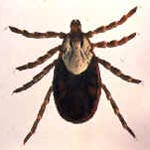Dermacentor andersoni
| Dermacentor andersoni | ||||||||||||
|---|---|---|---|---|---|---|---|---|---|---|---|---|

Dermacentor andersoni |
||||||||||||
| Systematics | ||||||||||||
|
||||||||||||
| Scientific name | ||||||||||||
| Dermacentor andersoni | ||||||||||||
| Stiles , 1908 |
Dermacentor andersoni (English Rocky Mountain wood tick ) is a member of the genus of the spotted ticks . The tick species is native to western North America, and its range extends from Mexico to British Columbia . The parasite cancause tick paralysis in cattle, especially calves. In the western United States, it is the main vector for Rocky Mountain spotted fever in humans and for anaplasmosis in ruminants ( anaplasma marginal pathogen).
features
Males are 2 to 6 mm long, females 3 to 5 mm, when fully sucked 10 to 11 mm. D. variabilis is brown and the back shield has a gray pattern. The mouthparts are short. The base of the capitulum is broad and short. The legs show the same pattern as the body. The first pair of coxes has a distinctive outer and inner spine.
development
D. andersoni is three host. Adults primarily feed on large herbivores, both domestic and wild, while the larvae and nymphs attack small rodents. Mating takes place on the host, after which the female lays up to 6500 eggs over a period of three weeks. The larvae hatch from these after four weeks and look for a host. After five days, they fall off and moult to become a nymph. The development can take place every one or two years. Larvae hatching in spring reach the nymph stage in late summer and overwinter as adults. Nymphs that cannot find a host overwinter and continue their development in the following year.
Individual evidence
- ^ A b c R. Wall, D. Shearer: Veterinary Entomology: Arthropod Ectoparasites of Veterinary Importance . Springer Science & Business Media, 2012, ISBN 978-94-011-5852-7 , pp. 125 .
